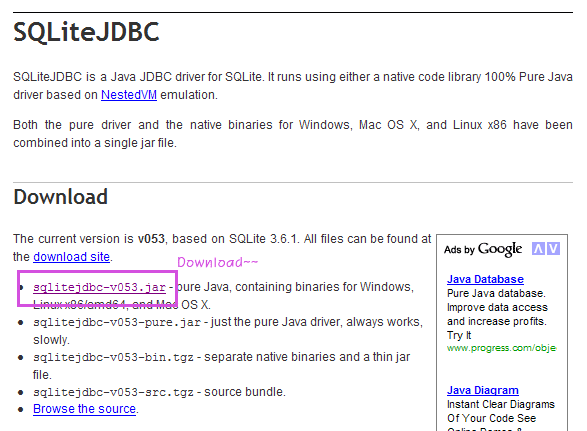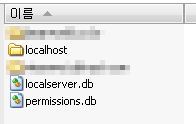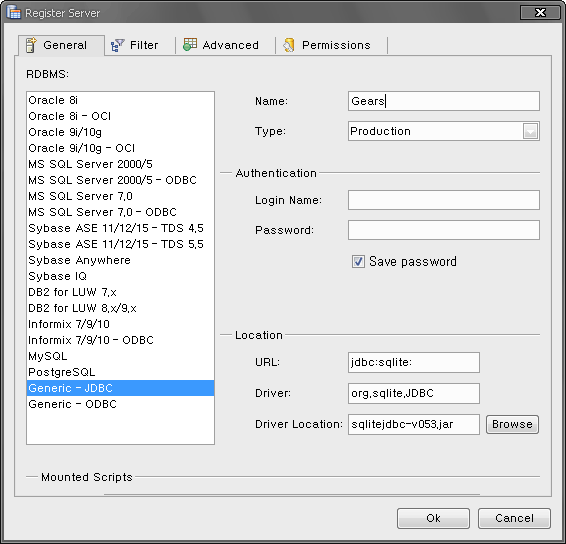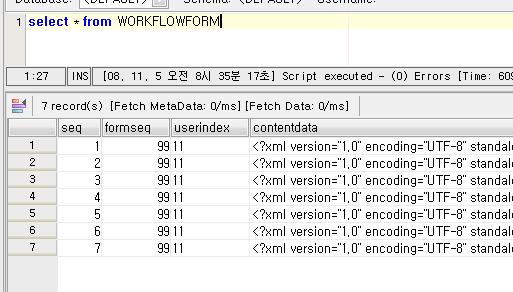Datatypes In SQLite Version 3
1. Storage Classes
Version 2 of SQLite stores all column values as ASCII text. Version 3 enhances this by providing the ability to store integer and real numbers in a more compact format and the capability to store BLOB data.
Each value stored in an SQLite database (or manipulated by the database engine) has one of the following storage classes:
NULL. The value is a NULL value.
INTEGER. The value is a signed integer, stored in 1, 2, 3, 4, 6, or 8 bytes depending on the magnitude of the value.
REAL. The value is a floating point value, stored as an 8-byte IEEE floating point number.
TEXT. The value is a text string, stored using the database encoding (UTF-8, UTF-16BE or UTF-16-LE).
BLOB. The value is a blob of data, stored exactly as it was input.
As in SQLite version 2, any column in a version 3 database except an INTEGER PRIMARY KEY may be used to store any type of value. The exception to this rule is described below under 'Strict Affinity Mode'.
All values supplied to SQLite, whether as literals embedded in SQL statements or values bound to pre-compiled SQL statements are assigned a storage class before the SQL statement is executed. Under circumstances described below, the database engine may convert values between numeric storage classes (INTEGER and REAL) and TEXT during query execution.
Storage classes are initially assigned as follows:
Values specified as literals as part of SQL statements are assigned storage class TEXT if they are enclosed by single or double quotes, INTEGER if the literal is specified as an unquoted number with no decimal point or exponent, REAL if the literal is an unquoted number with a decimal point or exponent and NULL if the value is a NULL. Literals with storage class BLOB are specified using the X'ABCD' notation.
Values supplied using the sqlite3_bind_* APIs are assigned the storage class that most closely matches the native type bound (i.e. sqlite3_bind_blob() binds a value with storage class BLOB).
The storage class of a value that is the result of an SQL scalar operator depends on the outermost operator of the expression. User-defined functions may return values with any storage class. It is not generally possible to determine the storage class of the result of an expression at compile time.
2. Column Affinity
In SQLite version 3, the type of a value is associated with the value itself, not with the column or variable in which the value is stored. (This is sometimes called manifest typing.) All other SQL databases engines that we are aware of use the more restrictive system of static typing where the type is associated with the container, not the value.
In order to maximize compatibility between SQLite and other database engines, SQLite support the concept of "type affinity" on columns. The type affinity of a column is the recommended type for data stored in that column. The key here is that the type is recommended, not required. Any column can still store any type of data, in theory. It is just that some columns, given the choice, will prefer to use one storage class over another. The preferred storage class for a column is called its "affinity".
Each column in an SQLite 3 database is assigned one of the following type affinities:
- TEXT
- NUMERIC
- INTEGER
- REAL
- NONE
A column with TEXT affinity stores all data using storage classes NULL, TEXT or BLOB. If numerical data is inserted into a column with TEXT affinity it is converted to text form before being stored.
A column with NUMERIC affinity may contain values using all five storage classes. When text data is inserted into a NUMERIC column, an attempt is made to convert it to an integer or real number before it is stored. If the conversion is successful, then the value is stored using the INTEGER or REAL storage class. If the conversion cannot be performed the value is stored using the TEXT storage class. No attempt is made to convert NULL or blob values.
A column that uses INTEGER affinity behaves in the same way as a column with NUMERIC affinity, except that if a real value with no floating point component (or text value that converts to such) is inserted it is converted to an integer and stored using the INTEGER storage class.
A column with REAL affinity behaves like a column with NUMERIC affinity except that it forces integer values into floating point representation. (As an optimization, integer values are stored on disk as integers in order to take up less space and are only converted to floating point as the value is read out of the table.)
A column with affinity NONE does not prefer one storage class over another. It makes no attempt to coerce data before it is inserted.
2.1 Determination Of Column Affinity
The type affinity of a column is determined by the declared type of the column, according to the following rules:
If the datatype contains the string "INT" then it is assigned INTEGER affinity.
If the datatype of the column contains any of the strings "CHAR", "CLOB", or "TEXT" then that column has TEXT affinity. Notice that the type VARCHAR contains the string "CHAR" and is thus assigned TEXT affinity.
If the datatype for a column contains the string "BLOB" or if no datatype is specified then the column has affinity NONE.
If the datatype for a column contains any of the strings "REAL", "FLOA", or "DOUB" then the column has REAL affinity
Otherwise, the affinity is NUMERIC.
If a table is created using a "CREATE TABLE <table> AS SELECT..." statement, then all columns have no datatype specified and they are given no affinity.
2.2 Column Affinity Example
CREATE TABLE t1(
t TEXT,
nu NUMERIC,
i INTEGER,
no BLOB
);
-- Storage classes for the following row:
-- TEXT, REAL, INTEGER, TEXT
INSERT INTO t1 VALUES('500.0', '500.0', '500.0', '500.0');
-- Storage classes for the following row:
-- TEXT, REAL, INTEGER, REAL
INSERT INTO t1 VALUES(500.0, 500.0, 500.0, 500.0);
3. Comparison Expressions
Like SQLite version 2, version 3 features the binary comparison operators '=', '<', '<=', '>=' and '!=', an operation to test for set membership, 'IN', and the ternary comparison operator 'BETWEEN'.
The results of a comparison depend on the storage classes of the two values being compared, according to the following rules:
A value with storage class NULL is considered less than any other value (including another value with storage class NULL).
An INTEGER or REAL value is less than any TEXT or BLOB value. When an INTEGER or REAL is compared to another INTEGER or REAL, a numerical comparison is performed.
A TEXT value is less than a BLOB value. When two TEXT values are compared, the C library function memcmp() is usually used to determine the result. However this can be overridden, as described under 'User-defined collation Sequences' below.
When two BLOB values are compared, the result is always determined using memcmp().
SQLite may attempt to convert values between the numeric storage classes (INTEGER and REAL) and TEXT before performing a comparison. For binary comparisons, this is done in the cases enumerated below. The term "expression" used in the bullet points below means any SQL scalar expression or literal other than a column value. Note that if X and Y.Z are a column names, then +X and +Y.Z are considered expressions.
When a column value is compared to the result of an expression, the affinity of the column is applied to the result of the expression before the comparison takes place.
When two column values are compared, if one column has INTEGER or REAL or NUMERIC affinity and the other does not, then NUMERIC affinity is applied to any values with storage class TEXT extracted from the non-NUMERIC column.
When the results of two expressions are compared, no conversions occur. The results are compared as is. If a string is compared to a number, the number will always be less than the string.
In SQLite, the expression "a BETWEEN b AND c" is equivalent to "a >= b AND a <= c", even if this means that different affinities are applied to 'a' in each of the comparisons required to evaluate the expression.
Expressions of the type "a IN (SELECT b ....)" are handled by the three rules enumerated above for binary comparisons (e.g. in a similar manner to "a = b"). For example if 'b' is a column value and 'a' is an expression, then the affinity of 'b' is applied to 'a' before any comparisons take place.
SQLite treats the expression "a IN (x, y, z)" as equivalent to "a = +x OR a = +y OR a = +z". The values to the right of the IN operator (the "x", "y", and "z" values in this example) are considered to be expressions, even if they happen to be column values. If the value of the left of the IN operator is a column, then the affinity of that column is used. If the value is an expression then no conversions occur.
3.1 Comparison Example
CREATE TABLE t1(
a TEXT,
b NUMERIC,
c BLOB
);
-- Storage classes for the following row:
-- TEXT, REAL, TEXT
INSERT INTO t1 VALUES('500', '500', '500');
-- 60 and 40 are converted to '60' and '40' and values are compared as TEXT.
SELECT a < 60, a < 40 FROM t1;
1|0
-- Comparisons are numeric. No conversions are required.
SELECT b < 60, b < 600 FROM t1;
0|1
-- Both 60 and 600 (storage class NUMERIC) are less than '500'
-- (storage class TEXT).
SELECT c < 60, c < 600 FROM t1;
0|0
4. Operators
All mathematical operators (which is to say, all operators other than the concatenation operator "||") apply NUMERIC affinity to all operands prior to being carried out. If one or both operands cannot be converted to NUMERIC then the result of the operation is NULL.
For the concatenation operator, TEXT affinity is applied to both operands. If either operand cannot be converted to TEXT (because it is NULL or a BLOB) then the result of the concatenation is NULL.
5. Sorting, Grouping and Compound SELECTs
When values are sorted by an ORDER by clause, values with storage class NULL come first, followed by INTEGER and REAL values interspersed in numeric order, followed by TEXT values usually in memcmp() order, and finally BLOB values in memcmp() order. No storage class conversions occur before the sort.
When grouping values with the GROUP BY clause values with different storage classes are considered distinct, except for INTEGER and REAL values which are considered equal if they are numerically equal. No affinities are applied to any values as the result of a GROUP by clause.
The compound SELECT operators UNION, INTERSECT and EXCEPT perform implicit comparisons between values. Before these comparisons are performed an affinity may be applied to each value. The same affinity, if any, is applied to all values that may be returned in a single column of the compound SELECT result set. The affinity applied is the affinity of the column returned by the left most component SELECTs that has a column value (and not some other kind of expression) in that position. If for a given compound SELECT column none of the component SELECTs return a column value, no affinity is applied to the values from that column before they are compared.
6. Other Affinity Modes
The above sections describe the operation of the database engine in 'normal' affinity mode. SQLite version 3 will feature two other affinity modes, as follows:
Strict affinity mode. In this mode if a conversion between storage classes is ever required, the database engine returns an error and the current statement is rolled back.
No affinity mode. In this mode no conversions between storage classes are ever performed. Comparisons between values of different storage classes (except for INTEGER and REAL) are always false.
7. User-defined Collation Sequences
By default, when SQLite compares two text values, the result of the comparison is determined using memcmp(), regardless of the encoding of the string. SQLite v3 provides the ability for users to supply arbitrary comparison functions, known as user-defined "collation sequences" or "collating functions", to be used instead of memcmp().
Aside from the default collation sequence BINARY, implemented using memcmp(), SQLite features two extra built-in collation sequences intended for testing purposes, the NOCASE and RTRIM collations:
- BINARY - Compares string data using memcmp(), regardless of text encoding.
- NOCASE - The same as binary, except the 26 upper case characters of ASCII are folded to their lower case equivalents before the comparison is performed. Note that only ASCII characters are case folded. SQLite does not attempt to due full UTF case folding due to the size of the tables required.
- RTRIM - The same as binary, except that trailing space characters are ignored.
7.1 Assigning Collation Sequences from SQL
Each column of each table has a default collation type. If a collation type other than BINARY is required, a COLLATE clause is specified as part of the column definition to define it.
Whenever two text values are compared by SQLite, a collation sequence is used to determine the results of the comparison according to the following rules. Sections 3 and 5 of this document describe the circumstances under which such a comparison takes place.
For binary comparison operators (=, <, >, <= and >=) if either operand is a column, then the default collation type of the column determines the collation sequence to use for the comparison. If both operands are columns, then the collation type for the left operand determines the collation sequence used. If neither operand is a column, then the BINARY collation sequence is used. For the purposes of this paragraph, a column name preceded by one or more unary "+" operators is considered a column name.
The expression "x BETWEEN y and z" is equivalent to "x >= y AND x <= z". The expression "x IN (SELECT y ...)" is handled in the same way as the expression "x = y" for the purposes of determining the collation sequence to use. The collation sequence used for expressions of the form "x IN (y, z ...)" is the default collation type of x if x is a column, or BINARY otherwise.
An ORDER BY clause that is part of a SELECT statement may be assigned a collation sequence to be used for the sort operation explicitly. In this case the explicit collation sequence is always used. Otherwise, if the expression sorted by an ORDER BY clause is a column, then the default collation type of the column is used to determine sort order. If the expression is not a column, then the BINARY collation sequence is used.
7.2 Collation Sequences Example
The examples below identify the collation sequences that would be used to determine the results of text comparisons that may be performed by various SQL statements. Note that a text comparison may not be required, and no collation sequence used, in the case of numeric, blob or NULL values.
CREATE TABLE t1(
a, -- default collation type BINARY
b COLLATE BINARY, -- default collation type BINARY
c COLLATE REVERSE, -- default collation type REVERSE
d COLLATE NOCASE -- default collation type NOCASE
);
-- Text comparison is performed using the BINARY collation sequence.
SELECT (a = b) FROM t1;
-- Text comparison is performed using the NOCASE collation sequence.
SELECT (d = a) FROM t1;
-- Text comparison is performed using the BINARY collation sequence.
SELECT (a = d) FROM t1;
-- Text comparison is performed using the REVERSE collation sequence.
SELECT ('abc' = c) FROM t1;
-- Text comparison is performed using the REVERSE collation sequence.
SELECT (c = 'abc') FROM t1;
-- Grouping is performed using the NOCASE collation sequence (i.e. values
-- 'abc' and 'ABC' are placed in the same group).
SELECT count(*) GROUP BY d FROM t1;
-- Grouping is performed using the BINARY collation sequence.
SELECT count(*) GROUP BY (d || '') FROM t1;
-- Sorting is performed using the REVERSE collation sequence.
SELECT * FROM t1 ORDER BY c;
-- Sorting is performed using the BINARY collation sequence.
SELECT * FROM t1 ORDER BY (c || '');
-- Sorting is performed using the NOCASE collation sequence.
SELECT * FROM t1 ORDER BY c COLLATE NOCASE;






